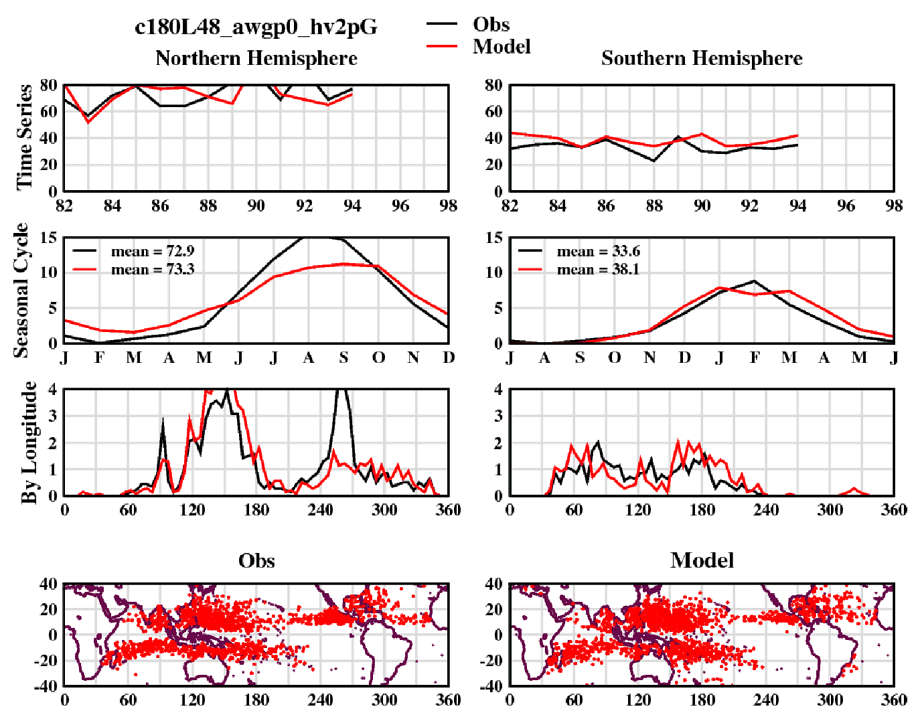TSTORMS Software Code
Detection and Diagnosis of Tropical Storms in High-Resolution Atmospheric Models
BACKGROUND
This code was designed to detect and track tropical cyclones in global climate models (GCMs) using data that is typically archived by GCMs. The code is meant to be used with atmospheric or coupled models with resolutions higher than 1 degree.
This software uses known physical features such as vorticity, vertical temperature, and moisture structure, to detect storms and categorize them by strength. TSTORMS is a single thread sequential program written in Fortran 77.
Global climate models are now achieving resolutions where tropical storms are seen in the resolved-scale flow. This is a recent development, and has allowed modelers to answer complex questions of great societal relevance such as: will the number of storms increase or decrease in a warming world? Will there be more or fewer destructive land-falling Atlantic hurricanes?

Sample plots generated by the TSTORMS
code. Top pair of panels show a comparison of storm counts in the
Northern and Southern hemispheres between observations (black) and the
50-km HiRAM C180 model (red) over the period 1982-1998. The next two
rows show similar comparisons over the climatological seasonal cycle,
and the meridional distribution of storms. The last row shows the
distribution of observed and modeled storms over the same period,
showing the ability of an SST-forced model to capture the distribution
of tropical storms worldwide.
NOAA/GFDL is one of the world’s leading centers of research in the study of tropical storms in a changing climate. In addition to the climate models developed by GFDL, other key tools are needed. TSTORMS allows us to:
- Find storms in the global temperature, water, and wind fields output by a model
- Track such a storm as it travels and evolves
- Count the storms that occur over a particular basin over a storm season
Running TSTORMS
Source
ftp://ftp.gfdl.noaa.gov/perm/GFDL_pubrelease/TSTORMS/TSTORMS.tar.gz
Environment Configuration
The following packages were used at GFDL to compile and run these tools. Newer
versions of these packages will likely work, but remain untested.
- tcsh (6.14.00)
- Intel Compilers (11.1.073)
- NetCDF (4.2)
- NCO (4.0.3)
- MPICH2 (1.2.1p1)
Compilation Instructions
Two Fortran programs need to be compiled.
- Open the tstorms_driver or trajectory_analysis directory.
- If needed, modify library locations in the Makefile.
- Run ‘make’ to compile the application.
- Repeat the above steps with the other application.
Usage Instructions
To see the available options, just pass the -h flag to the main script.
NAME tropical_storms_wsfc SYNOPSIS tropical_storms_wsfc.csh [-W] -b -e -n -i <input directory> -o <output directory> DESCRIPTION Creates figures and statistics from atmospheric data. OPTIONS -W Enables the use of w850 input data instead of wsfc. -b First year to start processing data. -e Last year to stop processing data. -n Experiment name. -i Location of post-processed input files. -o Location for storing the analysis data and figures.
The input filenames are expected to be in this format: atmos.1981010100-1981123123.slp.nc.
The script and associated Fortran applications will generate trajectory information which you can then plot separately with the tool of your choosing.
Referenced Works
- Knutson, Thomas R., Joseph J Sirutis, Stephen T Garner, Gabriel A Vecchi, and Isaac M Held, 2008: Simulated reduction in Atlantic hurricane frequency under twenty-first-century warming conditions. Nature Geoscience, 1(6), DOI:10.1038/ngeo202
- Vitart, F., D. Anderson, and T. N. Stockdale, 2003: Seasonal forecasting of tropical cyclone landfall over Mozambique. J. Climate,16,3932-3945.
- Vitart, F., J. L. Anderson, W. F. Stern, 1997: Simulation of Interannual Variability of Tropical Storm Frequency in an Ensemble of GCM Integrations. J. Climate: Vol. 10, No. 4, pp. 745-760.
- Vitart, F., T. N. Stockdale, 2001: Seasonal forecasting of tropical storms using coupled GCM integrations. MWR,129,2521-2537.
- Zhao, Ming, Isaac M Held, Shian-Jiann Lin, and Gabriel A Vecchi, December 2009: Simulations of global hurricane climatology, interannual variability, and response to global warming using a 50km resolution GCM. Journal of Climate, 22(24), DOI:10.1175/2009JCLI3049.1
Contacts
This software is provided under the GPLv2 license (please see the LICENSE file for more details). If you have questions about this package, you may contact GFDL’s climate model info mailing list: gfdl.climate.model.info@noaa.gov


